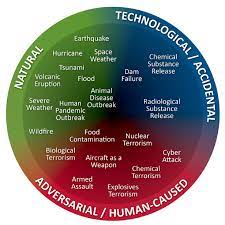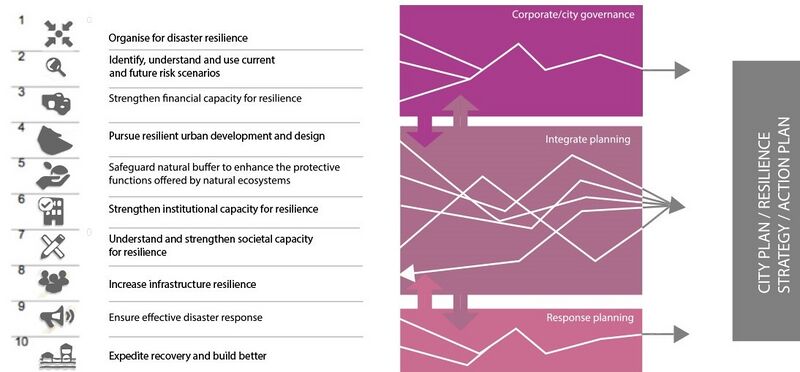City Resilience: Difference between revisions
Tag: Undo |
No edit summary |
||
| Line 1: | Line 1: | ||
{{Chapter | {{Chapter | ||
| | |image=Extreme_heat.jpg | ||
|poc=Jiri Skopek | |||
| | |authors=Jiri Skopek | ||
| | |blueprint=Resilience | ||
| | |sectors=Resilience | ||
| | |summary=The previous chapter focused on technology development to support whole community planning for disaster recovery, with emphasis on the requirements for multi-agency planning and decision -making involving an entire community and its physical, economic, and social resources. Technology development strategies to enhance City (or Community) Resilience are closely aligned with capabilities for disaster recovery, insofar as they involve the entire scope of community functions. | ||
| summary = The previous chapter focused on technology development to support whole community planning for disaster recovery, with emphasis on the requirements for multi-agency planning and decision -making involving an entire community and its physical, economic, and social resources. Technology development strategies to enhance City (or Community) Resilience are closely aligned with capabilities for disaster recovery, insofar as they involve the entire scope of community functions. | |email=jiri@skopek.ca | ||
}} | }} | ||
However, developing a technology strategy for enhancing the resilience of a community or region involves | However, developing a technology strategy for enhancing the resilience of a community or region involves | ||
Latest revision as of 23:40, January 24, 2024
| Resilience | ||||||||||||||||||||||||||
|---|---|---|---|---|---|---|---|---|---|---|---|---|---|---|---|---|---|---|---|---|---|---|---|---|---|---|

| ||||||||||||||||||||||||||
| Sectors | Resilience | |||||||||||||||||||||||||
| Contact | Jiri Skopek | |||||||||||||||||||||||||
| Topics | ||||||||||||||||||||||||||
Activities
| ||||||||||||||||||||||||||
- Authors
The previous chapter focused on technology development to support whole community planning for disaster recovery, with emphasis on the requirements for multi-agency planning and decision -making involving an entire community and its physical, economic, and social resources. Technology development strategies to enhance City (or Community) Resilience are closely aligned with capabilities for disaster recovery, insofar as they involve the entire scope of community functions.
However, developing a technology strategy for enhancing the resilience of a community or region involves more than focusing on disaster response or recovery (or disaster resistance, as it is sometimes called), or even on the single issue of public safety as traditionally defined. A holistic appro ach to resilience and community sustainability involves the broad spectrum of human activities and interactions within the community as the sum of relationships between four interconnected systems:
- The natural environment of geography, climate and weather;
- The built environment of the city habitat, its engineered systems, and physical infrastructure;
- The social environment of human population, communities and socio-economic activities; and
- An information ecosystem that provides the means for understanding, interacting with, and managing the relationships between the natural, built, and human environments.
As the nation and its communities become more connected, networked, and technologically sophisticated, new challenges and opportunities arise that demand a rethinking of current approaches to public safety and emergency management. An integrated approach to city and community resilience holds the potential to greatly enhance overall public safety, emergency response, and disaster recovery, while addressing new and emerging threats to public safety and security.
Community resilience-building is effectively an aspect of mitigation planning. Figure 12 illustrates the range and relationships among the hazards that community resilience programs in the public safety arena may need to address.

After nearly a decade of research, planning, policy development, and implementation, there is no shortage of models, frameworks, and guidance documents for developing and establishing a community resilience program. (By way of example, simply conduct an online search for “community resilience frameworks,” or “smart city.”) Widely accepted strategies include Sendai Framework for Disaster Risk Reduction 2015 - 2030 or Rockefeller 100 Resilient Cities program.
Resilience as defined by the Sendai Framework is the ability of a system, community, or society exposed to hazards to resist, absorb, accommodate, adapt to, transform and recover from the effects of a hazard in a timely and efficient manner, including through the preservation and restoration of its Essential basic structures and functions through risk management. Increasingly, in the context of cities resilience is framed around the ability to withstand and bounce back from both acute shocks (natural and manmade) such as floods, earthquakes, hurricanes, wild-fires, chemical spills, power outages, as well as chronic stresses occurring over longer time scales, such as groundwater depletion or deforestation, or socio-economic issues such as homelessness and unemployment.
The United Nations Disaster Resilience Scorecard for Cities is a recommended starting point for cities to self-assess their preparedness. This Scorecard is structured around the “Ten Essentials for Making Cities Resilient”, first developed as part of the Hyogo Framework for Action in 2005, and then updated to support implementation of the Sendai Framework for Disaster Risk Reduction: 2015-2030.

As shown in Figure 13, the Ten Essentials for Making Cities Resilient offer a broad coverage of the many issues cities need to address to become more disaster resilient:
- Essentials 1-3 cover governance and financial capacity;
- Essentials 4-8 cover the many dimensions of planning and disaster preparation;
- Essentials 9-10 cover the disaster response itself and post-event recovery.
Planning Strategies
A city is a system of systems, with each of those systems (e.g. communications, water, sanitation, energy, healthcare, welfare, law and order, education, businesses, social and neighborhood systems) potentially having separate owners and stakeholders. Resilience needs consideration within and across each of these systems and therefore can only be achieved through effective collaboration.
A range of actors —whether government, private business, community groups, academic institutions, other organizations or individuals—have roles to play in maintaining and improving city resilience. Ideally, local government authorities (which often have the best convening power) should take the lead in conducting the assessments of the Scorecard. A multi -stakeholder dialogue and approach between key city stakeholders will be necessary to complete the Scorecard, and is essential in the push towards more resilient cities.
Local governments that have used the Scorecard have found it useful at a range of levels:
- As a high-level survey, often via a 1 or 2-day workshop – this can be supported by questionnaires that participants fill out in advance. Sometimes an average or consensus score is applied at the level of each of the “Ten Essentials,” rather than for each individual criteria / assessment;
- As a limited exercise focusing on some individual Essentials, to create an in-depth review of some specific aspects of resilience, e.g. community-level preparedness;
- As a detailed review of the city’s entire resilience position, likely to take one to several months to complete.
- In light of user feedback, the Scorecard now offers the potential for scoring at two levels:
- Level 1: Preliminary level, responding to key Sendai Framework targets and indicators, and with some critical sub-questions. This approach is suggested for use in a 1 to 2-day city multi-stakeholder workshop. In total, there are 47 questions / indicators, each with a 0 – 3 score;
- Level 2: Detailed assessment. This approach is a multi-stakeholder exercise that may take 1–4 months and can be a basis for a detailed city resilience action plan. The detailed assessment includes 117 indicator criteria, each with a score of 0 – 5. Note that the criterion in the detailed assessment may serve as helpful discussion prompts for a preliminary level workshop.
Some intentional overlap exists between the preliminary and detailed assessments. Cities completing the detailed assessment should find it easier if they have already completed the preliminary. The detailed assessment is designed to build on the preliminary, but prompts deeper thought, review and consultation.
While the Scorecard aims to be systematic, individual scores may unavoidably be subjective – use judgment to decide which scores apply most closely to your level of disaster resilience. Recording your justification for each evaluation score will enable validation, as well as future revisions and tracking of progress;
- Disaster risk reduction and building resilience needs to be a collaborative effort. Some aspects of disaster resilience may not be under the control of local governments (for example, the city’s electricity supply or phone system may be operated by a separate agency or private utility, or there may be a provincial or neighboring government that also needs to be involved). The Scorecard should be completed in consultation with these other organizations. The consultation process will also help to engage and build understanding, ownership and alignment with these other organizations;
- Consulting citizen groups as you complete the Scorecard will improve the validity of your results;
- Being as accurate and realistic as possible will help identify areas of vulnerability, enabling their prioritization for attention and funding;
- The Scorecard may not address all the disaster resilience issues facing your city. If in doubt, take advice from an expert in risk management or another relevant discipline.
- The Scorecard provides an aspirational definition of disaster resilience – it is unlikely that any city will score maximum points, and most will not score more than 50%. The intention of the Scorecard is to guide cities towards improved disaster risk reduction, and to challenge complacency.
- The scores are not normative and therefore not comparable across different cities. The Scorecard was not designed to facilitate competition between cities, but to identify and promote sharing of knowledge.
Considerations for Technology Development and Insertion
The challenges or threats to public safety and security depicted in Figure 12 offer opportunities for introducing technology advancements to improve the resilience and sustainability of the overa ll community ecosystem. RDT&E of advanced technologies would, for example, include such priorities as:
- Design and integration of intelligent infrastructure—including embedded sensors, IoT, wireless information technologies, and real-time data capture and analysis;
- Improvements in environmental monitoring and predictive analytics that could contribute to public health monitoring, as well as the monitoring of geological and environmental conditions;
- Resilient infrastructure design with emphasis on electrical grid and telecommunications systems that can sustain public communications and connectivity during emergencies and disasters;
- Enhanced data analytics leading to better modeling and display of decision-making within multi-agency and multi-disciplinary team systems, that are appropriate to Blue-Sky city management and daily operations, but which can transition seamlessly to high-criticality decision-making under the stress of Dark-Sky disasters and civil emergencies.
In this regard, the technology development projects within GCTC member communities exemplify the range of technologies and concepts with potential for improving the overall community resilience. Currently, the SuperClusters are organized into five areas of research and development for technology insertion:
- Transportation
- Utilities (Energy/Water/Waste Management)
- City Data Platform
- Public Wireless / Broadband
- Cybersecurity and Privacy
- Public Safety
- Agriculture and Rural
- Smart Buildings
- Education
- Health and Thriving Communities
Collectively, these SuperClusters represented over 120 participating city and technology developer teams, and a portfolio of over 130 Smart City Applications, each of which contributes to some aspect of improving the resilience, health, safety, or quality of life within a connected community.
The next section offers a general approach for designing and implementing a Smart Public Safety Program within a Smart and Connected Community. Like this Blueprint, itself, the approach is based on the initial work of the PSSC during its first year, and will be expanded with input from PSSC member communities and Action Clusters, based on the real-world experience of developing, piloting, and implementing smart technology applications for public safety, disaster response and recovery, and community resilience.





